LEA SYMBOLS®
Playing Cards
#252500

Of the four sets of cards included in the LEA SYMBOLS® test materials, the Playing Cards is the easiest test in measuring the visual acuity of very young children. It is used in examination of older children with brain damage to reveal the difference between visual acuity values measured with the Playing Cards and with single optotypes, line test and tightly crowded optotypes. It functions also as regular teaching material when a child is learning the concepts of similar/different, big/small, and bigger/smaller. Children may have funny names for the forms, for example, the ”apple” can be ”slippers”, ”bunny ears”, name of any kind of fruit, the “house” can be “dog house”, “barn”, “cottage”, “arrow” and even “mouse” (the arrow of the mouse on the computer screen). So always say “that is an interesting name” and gently do not allow parents to interfere.
If we want to measure the visual acuity of a typically developing young child, we first use the LEA 3-D Puzzle (#251600). When the concept of “same” is familiar with concrete forms, it is time to try to place the puzzle pieces on their pictures, first on large pictures and then smaller and smaller pictures of the Playing Cards. Often the child starts to use some names for the pictures, which makes the test much faster. All names are accepted.
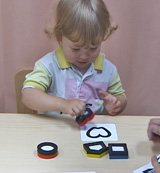


A young child (27 months) training with concept "same".
Basic measurement with single symbol test
To measure the visual acuity with the Playing Cards first choose the mode of answering. If the child can recognise the four pictures and has names or signs for them or can use the keycard or the LEA 3-D Puzzle for matching, you can start:
-
Show one of the cards with the largest symbols at a distance of 20-40cm (= well within the visual sphere of the child) on the table as in the above pictures (Figure 1) or hold the card below the eye level in the air.
-
If the answer is correct, move to the next symbol size and show a card with a symbol different from the one shown (children do not tend to answer using the same name twice after each other)
-
Go on like this until the smallest cards where the child gets 3 out of 5 correct. You need to show one of the four cards twice.
- Calculate the visual acuity value:
VA = distance in meters / M size =m/M
If the child sees the smallest symbols, the 0.63M cards all correctly at 40cm, show them at 60cm (2’), where they correspond to visual acuity 1.0 (6/6, 20/20). If the child sees all cards correctly at 60cm, do not move further, because 60cm is already at the outer edge of the near vision activities of young children and children with developmental delays. Mark on the recording sheet: VA > 1.0 (6/6, 20/20) with Playing Cards at 60cm (2’).
At close distances a small change in the distance affects the visual acuity value more than in testing at a longer distance, so try to keep the distance the same and measure it with the span of your hand (between the tip of your thumb and your little finger; not with a ruler).
Children with intellectual disability use the same technique as the young children, often using both placing the card on the Puzzle board and naming at the same time.
Figure 2.
Children with intellectual disability often have weak understanding on the word “same” although they can match the picture on the card with a large picture with the same optotype. If the child places the Playing Card on a wrong cut-out of the LEA 3-D Puzzle as in the video above but at the same time says the correct name, “doghouse”, then we ask where the child has the doghouse on the puzzle. We may need to ask the child which picture is on the card. The child may say the correct name even if matching was incorrect.
Never let the child know that an answer was incorrect. If child’s motivation disappears, try another day.These children are best tested as a part of regular one-to-one teaching sessions in a quiet corner so that no noises interrupt the play.
Measurement of visual acuity with single optotype tests is often the first visual acuity test when starting to test children with major communication problems, like speechless children with severe CP. They often need to train fixating on a line test, which becomes a part of therapies or teaching. These children perform much better during testing, if their own therapist or teacher supports the child’s head and body control.
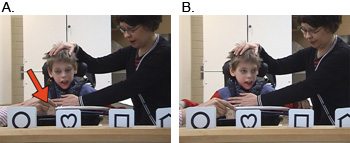
Figure 3.
Measurement of near vision acuity of a child using LEA Playing Cards. A. The child needs to be supported; the therapist does not look at the test card in the tester’s hand (arrow). B. The child answers with gaze pointing and head turn, which is recorded on video or there is a third person, who registers the response of the child. We need thus three persons to do the test.
Children with severe cerebral palsy and communication problems are first tested with the Playing Cards to find out what their best visual acuity value might be at close distances. The test card is shown to the child at a distance where we know the image to be clear without spectacles or give the child proper near correction before testing. In front of the child there are large answering cards facing the child and the video camera, which records the child’s gaze shift from the test card to the big card. The child uses gaze pointing supported by turning his head. In these children eye movements often are not differentiated from head movements.
This kind of testing takes time and is often possible only at a certain time during the day. Therefore testing at school is important both when the child is functioning at best and also when his functioning is poor. This helps the teachers to plan the demanding near tasks to the short time periods when the student’s visual functioning is best.
Training situations for young children and older students
Young children and older students with developmental delay may need one-to-one play situations with you to get accustomed to play with the small cards. When playing with older children, watch that the student does not put a card in his/her mouth. Although the cards are printed on paper and will be digested they are not meant to be eaten.
Level I: Sorting each symbol type separately
-
All Playing Cards with the symbol "house" are stacked one by one next to the "house" Flash Card. Then do the same with the "apple," "ball," and "box."
Level II. Sorting two or more symbols
-
Give the child a mix of two different symbol shapes in all different sizes and have him sort them by matching them up with the corresponding Flash Card.
If the number of cards is too much for the child, choose three to four of the biggest sizes of both symbols. Next time you play you can choose smaller sizes.
-
Repeat Step 1 and add a third symbol and the matching Flash Card. Then repeat, adding the fourth symbol.
-
Instead of placing the Playing Cards into stacks, make neat rows of cards next to the Flash Card(s).
-
Sort the cards within the row in the order from the biggest to the smallest.
In each game situation, make sure you do not use symbols that are too small for the child to see. Later you can introduce a smaller size by having the child look at it from a shorter distance or with a magnifying device.
If the child wants to play with the 3D forms in the middle of the game, allow that, because the child may need tactile confirmation.
Visual Acuity
During the games, it becomes obvious which size of symbols is the smallest that the child can respond to, thus giving you approximate visual acuity value. To determine the child's visual acuity you need to measure the distance at which the smallest symbols are seen. Use your hand’s span to measure the distance rather than a ruler so as not to disturb the play situation. You can also measure visual acuity by asking the child to place the corresponding LEA 3-D Puzzle piece on the card that you place in front of the child, as shown in the Figure 1.
If you use the LEA Playing Cards as a game playing “pairs”, the child may be motivated to get quite close to the recognition threshold (Figure 4).
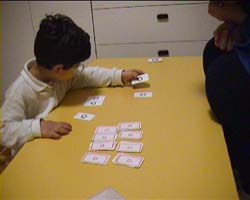
Figure 4.
Visual acuity values
The Snellen fractions are not logical to use in near vision because they give a wrong idea of the measurement. For example, visual acuity 20/80 (6/24) measured at a distance of 40cm (16in) should be written 16/64 or 40/160 but nobody would recognise these as visual acuity values. The use of decimal visual acuity values would solve the problem but so far decimal VA values have not become popular in countries where the Snellen fractions are used. When using the decimal value it is important to write down the distance where the measurement was made.
The M size, i.e. the actual size of the symbol, is printed on the back of the Playing Cards. Tables 1-3 give you the visual acuity values when measured at 16, 8 or 4 inches (at 40cm, 20cm or 10cm).
If the child recognized the 1.0M symbols at a distance different from the three distances given in the table, for example at 5", the visual acuity is calculated using the closest distance in the Table 1, in this case 4 in.
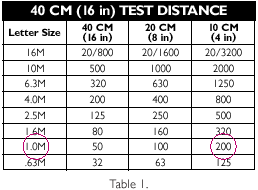
![]()
Similarly, if the British notation is used and the 1.6M cards were seen at 12cm distance:
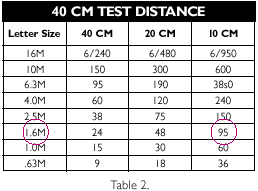
![]()
If the decimal notation is used, the calculation is following: 12cm/10cm x 0.06 = 0.07 or you use the formula in the beginning of the text: VA=m/M.
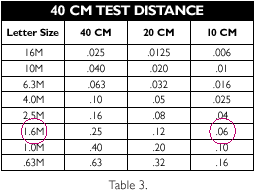
When using the metric system, visual acuity can also be calculated simply by dividing the distance used (in meters) by the M-value: 0.12m/1.6M = 0.07.
If the calculations are found to be difficult, writing down the M-value and the distance used is enough for follow-up. When visual acuity values of the eyes need to be compared, as during the follow-up of training of an amblyopic eye, show the cards to the child at the same distance when testing each eye monocularly. Then you can see the difference in visual acuity values as the number of lines of visual acuity without any calculations.
M-unit, metric unit is the distance in meters at which the reference optotype C is seen at a visual angle of 5'.
[ Instructions I Paediatric Vision Tests I Vision Tests ]
This document was last modified on